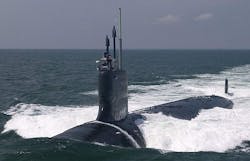Navy orders 10 Virginia-class attack submarines from Electric Boat in $17.8 billion contract
WASHINGTON, 30 April 2014. U.S. Navy leaders moved this week to safeguard the nation's advanced submarine capability over the next decade and beyond with a potential $17.8 billion contract to build 10 Virginia-class fast-attack submarines from General Dynamics Electric Boat in Groton, Conn.
Officials of the Naval Sea Systems Command in Washington announced the contract late Monday. “This is the largest number of boats ordered to date in a single contract block, which is great news -- particularly in light of today’s challenging economic and political environments,” says Matt Mulherin, president of General Dynamics partner Newport News Shipbuilding in Newport News, Va.
Compared to their predecessors such as the U.S. Seawolf- and Los Angeles-class attack submarines, the Virginia class offers several electronic, electro-optical, and propulsion innovations not previously built into other submarine classes.
The Virginia class, for the first time, has no opening in its pressure hull through which a conventional periscope raises and lowers. Instead, the nation's newest submarine class have photonics masts with high-resolution daylight cameras, light-intensification and infrared sensors, an infrared laser rangefinder, and special electronics to intercept enemy communications.
Related: Lockheed Martin to upgrade electro-optical imaging systems for Navy submarine fleet
Instead of passing through an opening in the boat's pressure hull, which can create a weak spot in combat, signals from photonics mast sensors enter the submarine via optical fiber for signal processing in the boat's command center.
In addition, the Virginia class also has improved sonar systems and electromagnetic signature reduction to reduce the possibility of enemy detection. The boat has a bow-mounted spherical active and passive sonar array, a wide aperture lightweight fiber optic sonar array, and two high-frequency active sonars in the sail and keel.
The Virginia class also has low-frequency and high-frequency towed sonar arrays, a chin-mounted high-frequency sonar to supplement the boat's main sonar array for operations in coastal waters and to detect enemy submarines.
Instead of traditional bladed propellers, the Virginia class has pump-jet propulsors to reduce the risks of cavitation and enable quieter operation than traditional propellers allow. The boat also has fiber-optic fly-by-wire ship control, AN/BYG-1 combat system, and nine-man lockout chamber for covert insertion of Special Operations forces.
Monday's multi-year block IV contract enables Electric Boat and teammate, Newport News Shipbuilding to build two submarines per year over the next five years. Construction of the first Block IV submarine, SSN 792, will begin May 1. The 10th ship to be procured under this contract is scheduled for delivery in 2023.
Virginia-class submarines are designed for anti-submarine and surface ship warfare and special operations support, as well as intelligence, surveillance, and reconnaissance (ISR). They are to replace legacy Los Angeles-class attack submarines as the older boats are retired. Los Angeles-class subs have been at sea since the 1970s.
Electric Boat and Newport News Shipbuilding already have delivered 10 Virginia-class submarines to the Navy, General Dynamics officials say. They are USS Virginia (SSN 774), USS Texas (SSN 775), USS Hawaii (SSN 776), USS North Carolina (SSN 777), USS New Hampshire (SSN 778), USS New Mexico (SSN 779), USS Missouri (SSN 780), USS California (SSN 781), USS Mississippi (SSN 782), and USS Minnesota (SSN 783). Eight additional submarines are under construction.
Related: General Dynamics continues project to upgrade submarine electronics with COTS computers
Virginia-class submarines displace 7,800 tons, are 377 feet long, and 34 feet in diameter. They can travel faster than 25 knots and dive deeper than 800 feet. They carry Mark 48 advanced capability torpedoes, Tomahawk land-attack missiles, and unmanned underwater vehicles (UUVs).
The $17.6 million contract announced Monday has options that could bring its value to $17.8 million, Navy officials say. General Dynamics and Newport News Shipbuilding will do the work in Newport News, Va.; Groton, Conn.; Quonset Point, R.I.; Sunnyvale, Calif.; Cheswick, Pa.; Annapolis, Md.; and other sites throughout the U.S., and should be finished by August 2024.
For more information contact General Dynamics Electric Boat online at www.gdeb.com, Newport News Shipbuilding at http://nns.huntingtoningalls.com, or Naval Sea Systems Command at www.navsea.navy.mil.

